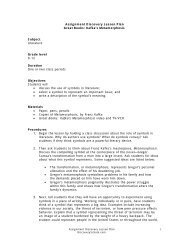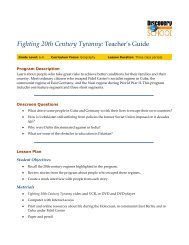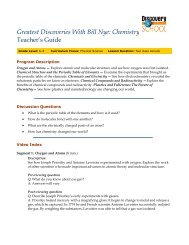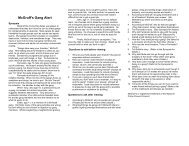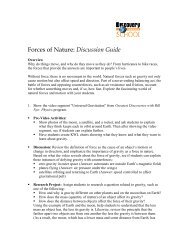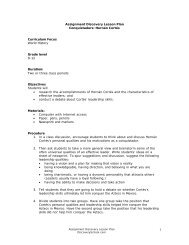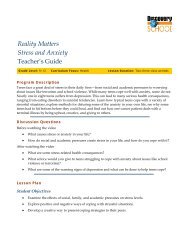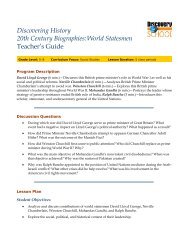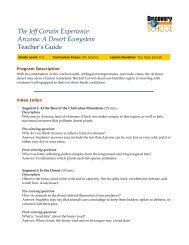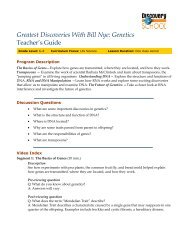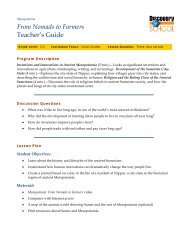Forensic Detectives: Chemistry At Work - Discovery Education
Forensic Detectives: Chemistry At Work - Discovery Education
Forensic Detectives: Chemistry At Work - Discovery Education
You also want an ePaper? Increase the reach of your titles
YUMPU automatically turns print PDFs into web optimized ePapers that Google loves.
<strong>Forensic</strong> <strong>Detectives</strong>: <strong>Chemistry</strong> at <strong>Work</strong>: Teacher’s Guide 6<br />
Mid-continent Research for <strong>Education</strong> and Learning (McREL)<br />
McREL's Content Knowledge: A Compendium of Standards and Benchmarks for K-12 <strong>Education</strong><br />
addresses 14 content areas. To view the standards and benchmarks, visit http://www.mcrel.org/.<br />
This lesson plan addresses the following national standards:<br />
• Science—Physical Sciences: Understands the structure and properties of matter<br />
• Language Arts—Viewing: Uses viewing skills and strategies to understand and interpret<br />
visual media; Reading: Uses reading skills and strategies to understand and interpret a<br />
variety of informational texts<br />
• Technology— Understands the relationships among science, technology, society, and the<br />
individual<br />
Support Materials<br />
Develop custom worksheets, educational puzzles, online quizzes, and more with the free teaching tools<br />
offered on the <strong>Discovery</strong>school.com Web site. Create and print support materials, or save them to a<br />
Custom Classroom account for future use. To learn more, visit<br />
DVD Content<br />
• http://school.discovery.com/teachingtools/teachingtools.html<br />
This program is available in an interactive DVD format. The following information and activities are<br />
specific to the DVD version.<br />
How To Use the DVD<br />
The DVD starting screen has the following options:<br />
Play Video—This plays the video from start to finish. There are no programmed stops, except by<br />
using a remote control. With a computer, depending on the particular software player, a pause<br />
button is included with the other video controls.<br />
Video Index—Here the video is divided into four parts (see below), indicated by video thumbnail<br />
icons. Watching all parts in sequence is similar to watching the video from start to finish. Brief<br />
descriptions and total running times are noted for each part. To play a particular segment, press<br />
Enter on the remote for TV playback; on a computer, click once to highlight a thumbnail and read<br />
the accompanying text description and click again to start the video.<br />
Curriculum Units—These are specially edited video segments pulled from different sections of the<br />
video (see below). These nonlinear segments align with key ideas in the unit of instruction. They<br />
include onscreen pre- and post-viewing questions, reproduced below in this Teacher’s Guide. Total<br />
Published by <strong>Discovery</strong> <strong>Education</strong>. © 2005. All rights reserved.



